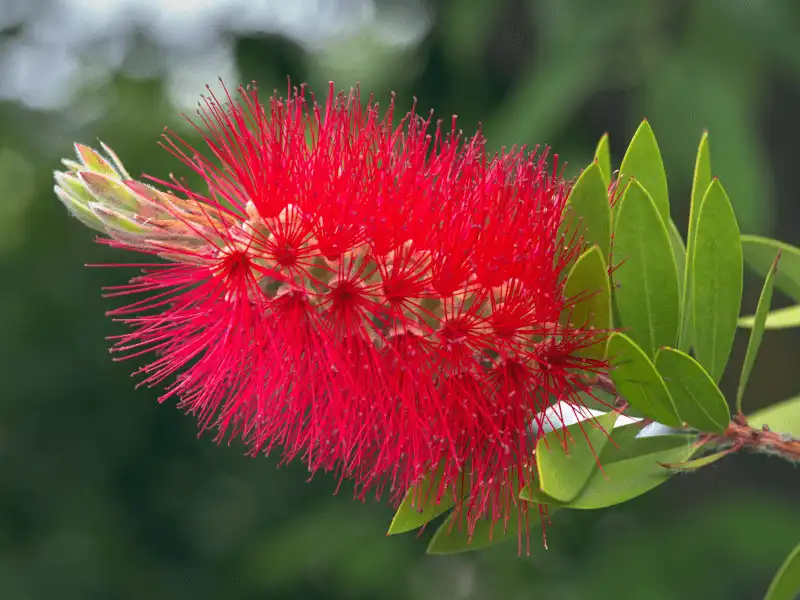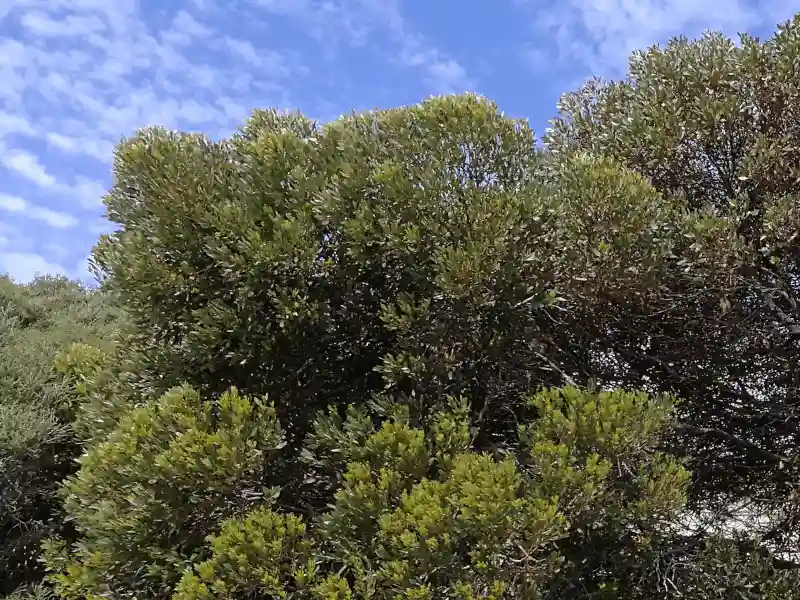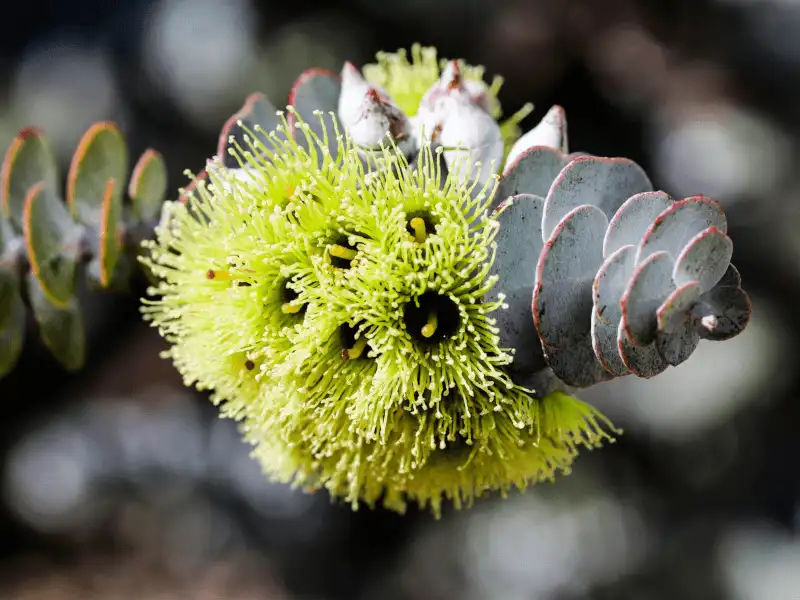
| Botanic name | Callistemon viminalis |
| Other names | Weeping bottlebrush |
| Main Origin | East coast of Australia |
| Mature size | 5 – 10 m x 6 – 10 m (w x h) |
| Mature form | Shrub or small tree with an open or dense canopy |
| Foliage | Linear, narrow-elliptical, mid to dark green |
| Growth rate | Moderate to fast |
| Position | Full sun, part shade |
| Soil | Adapts to most soils |
| Water | Minimal, deep watering during the establishment |
| Climate | Mediterranean, temperate, subtropical, tropical |
| Flower | Vibrant red, cylindrical spikes in spring and autumn |
| Use | Feature specimen, hedge, screening, avenue planting |
| Notes | Tolerant of wet conditions, suitable for coastal sites |
IN THIS ARTICLE
Overview
Callistemon viminalis, or Weeping Bottlebrush, is one of Australia’s most iconic and beloved native species. Known for its graceful, cascading branches and vibrant crimson flower spikes, it brings both drama and softness to gardens, streetscapes, and parklands alike.
This species isn’t just a showpiece. It is also remarkably tough, thriving in a wide range of environments from damp floodplains to dry urban nature strips.
With its striking visual appeal and adaptability, Callistemon viminalis has inspired a vibrant collection of cultivars, making it easy for gardeners and designers to find a form that suits their space, from neat hedges to elegant shade trees.

Origin and distribution
Callistemon viminalis is native to the northeastern coast and nearby regions of Australia. It is perhaps the most well-known and cultivated bottlebrush in Australia and abroad, due to its versatility, adaptability, and ornamental appeal.
In the wild, it thrives along watercourses, floodplains, and moist gullies, where its pendulous branches often trail over creeks and seasonal streams. Its preference for these damp environments sets it apart from many other native species, giving it a unique ecological role in stabilising soil and supporting native biodiversity.
Despite its natural affinity for moisture, Callistemon viminalis has proven highly adaptable and is now widely cultivated in drier regions. It has become a popular feature in urban and suburban landscapes across Australia.
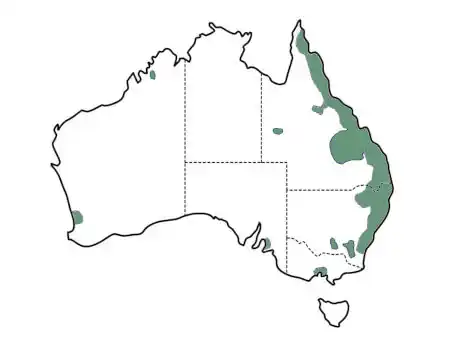
Growth and care
A key reason that Callistemon viminalis has become a landscape favourite is its ease of growth and adaptability. Whether you are working with a formal or a more naturalistic garden, this species is remarkably low-maintenance.
It thrives and flowers profusely in full sun, although the species can tolerate light shade. Its natural habitat along watercourses means it can handle wet or poorly drained soils better than many other natives, making it highly suitable for sites subject to periodic flooding, bogginess or waterlogging.
While this plant naturally thrives in moist environments, it adapts well to drier conditions and is surprisingly drought-tolerant once established. The plant naturally thrives best in slightly heavy soils, but is not fussy with soil types, so long as they are slightly acidic to neutral.
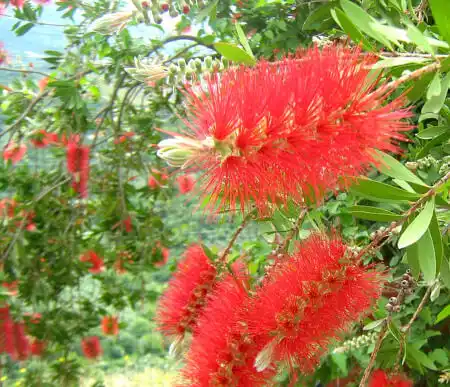
Callistemon viminalis can tolerate some coastal exposure. However, as it is not the first-line coastal species, avoid sites subject to persistent strong salt-laden winds and high soil salinity. The species can generally tolerate frost, but its cultivars have a varying degree of tolerance.
The plant can grow in nutrient-poor soils. However, applying compost and balanced fertilisers during spring and summer can promote healthy, optimal growth and flowering.
Callistemon viminalis responds well to pruning. Some cultivars are better kept as neat hedging or screening plants, while others are more appealing in their natural, flowing form. Prune after flowering, so the plant can focus on new growth and generate more flowers in the next season.
Hedging or screening varieties benefit hugely from regular trimming or tip pruning to rejuvenate their growth while maintaining density, size and shape. In contrast, a feature specimen should be pruned carefully, as excessive cutting can disrupt its visual appeal.
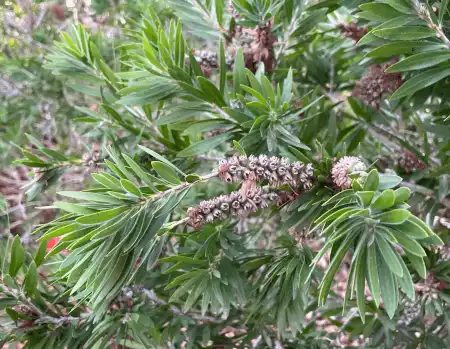
Features
Callistemon viminalis is a standout native plant not just for its resilience, but also for its striking ornamental qualities that transform any landscape.
The mature plant is multi-trunked with dark and furrowed bark, contributing to its character and overall visual appeal.
It typically develops a broad, rounded canopy that appears almost fountain-like, dense at the crown and flowing elegantly toward the ground.
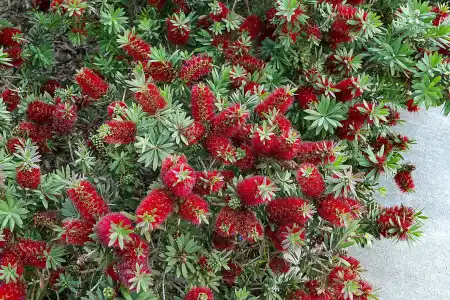
The graceful weeping branches are adorned with narrow, mid- to dark-green leaves. They cascade beautifully, creating a sense of flow and harmony while adding textural interest.
The striking combination of weeping branches and their horizontal spread form a strong focal point while maintaining a light, airy feel.
An iconic attribute is its profuse, brilliant red bottlebrush-like flowers, which emerge in spring and often again in autumn. These cylindrical flower spikes, rich in nectar, attract birds and pollinators, making the tree a lively hub of activity in any garden.
Following flowering, Callistemon viminalis produces small, woody seed capsules that can remain on the branches in tight clusters, a classic feature of bottlebrush plants.
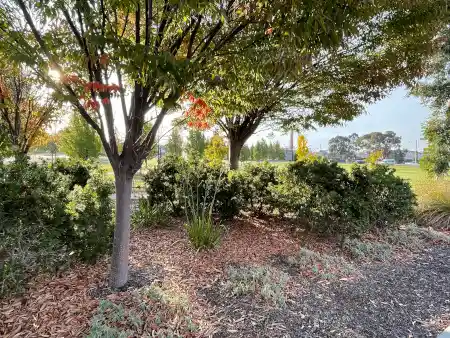
Varieties
Callistemon viminalis has inspired a remarkable array of cultivars, each offering unique size, form, and flower colour. This diversity allows for tailored applications for different landscape purposes.
Compact and dwarf forms
- Little John: An attractive variety with soft blue-green foliage, suitable for low hedges, borders, and container planting, reaching 1 metre in height and width.
- Green John: Similar to ‘Little John’ in growth habit, featuring fresh light green growth that contrasts beautifully with older dark green foliage.
- Better John: An “improved” version of ‘Little John’, with quicker establishment, faster growth, and attractive silver-toned new growth.
- Little Silver: Similar stature and compactness to ‘Little John’, with small vibrant red flowers, bolder foliage and silvery-toned new growth.
- Little Caroline: Grows faster and larger than ‘Little John’, with longer and deeper green leaves, growing 1 – 1.5 metres tall.
- Scarlet Flame: A highly compact variety with finer foliage, featuring rustic red new growth and bright red flowers, reaching 1 – 1.5 metres tall.
- Green Envy: An even smaller, more compact variety that grows to 0.5 – 1 metre in height, featuring dense, lush, and vibrant green foliage.
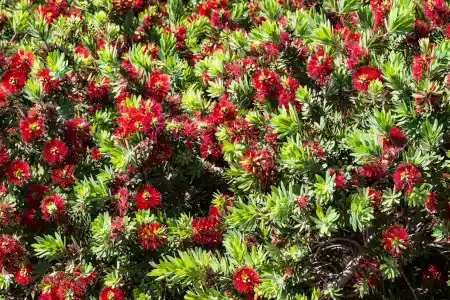
Medium to large shrubs and trees
- Captain Cook: A compact cultivar highly suitable for hedging and screening, featuring spectacular, prolific crimson flowers, growing to 1.5 – 2 metres tall.
- Macarthur: A cross between ‘Captain Cook’ and ‘Little John’, featuring a more compact habit, faster growth, fresh green foliage and deeper red flowers, growing to 1.5 – 2 metres.
- Rose Opal: A compact variety that features striking red-pink flowers and fine green foliage, reaching 1.5 – 2 metres in height.
- Red Alert: A compact variety suitable for hedging or screening, featuring bronzy red new growth, growing 2 – 2.5 metres tall.
- Wilderness White: A graceful, weeping variety featuring profuse, white bottlebrush flowers and dense, soft green foliage, reaching 2 – 3 metres tall.
- Slim: A compact variety with a narrow habit for hedging or screening in tight places, bringing all usual qualities of foliage and blossoms, reaching 3 metres tall.
- Clearview White: A popular bushy variety for hedging or screening, featuring arching branches and fuzzy white bottlebrush flowers, growing 3 metres tall.
- Wildfire: A graceful variety with a slightly weeping habit, featuring profuse, large, bright red flowers, reaching 2 – 4 metres tall.
- Hannah Ray: A versatile screening shrub or small tree, 4 – 5 metres tall, featuring stunning cascading branches and profuse, large, red flowers.
- Prolific: A prolific flowering variety, with weeping branches and a dense and compact habit, growing to 4 – 6 metres in height.
- Dawson River Weeper: A variety with a strong pendulous habit, featuring soft grey-green, cascading foliage and a wider spread, reaching 4 – 6 metres tall.
